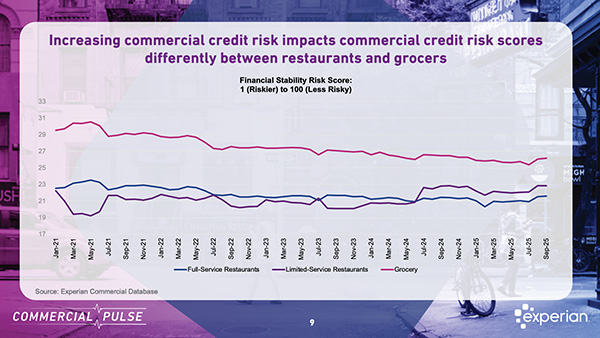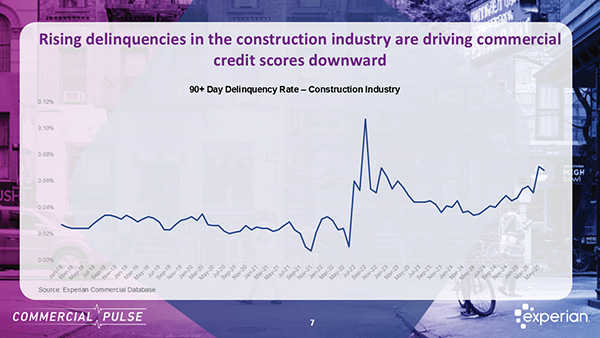At A Glance
Explore retail industry risk trends for Q4 2025 inventory gaps and credit shifts impact CRO strategies in the latest Commercial Pulse Report.As we enter the final stretch of the year, the retail sector is bracing for its most critical quarter—and the pressure is mounting. While consumer spending intentions remain historically strong, inventory levels are trailing demand, and discretionary retail continues to show signs of stress. For Chief Risk Officers managing exposure across commercial credit portfolios, this year’s holiday season demands a recalibrated lens on retail performance and credit risk.
Watch the Commercial Pulse Update
As you will read in the latest Commercial Pulse Report for November 11, 2025, retail sales posted a year-over-year gain of 5.0% in August, with a 0.6% increase month-over-month. Stripping out autos and gas, the underlying sales trend rose 0.7%, reflecting sustained demand across core categories. On the surface, this suggests stable footing as the industry heads into Q4.
But beneath that surface, the risk picture is more nuanced.
Inventory Constraints May Reshape Holiday Pricing
One of the more critical data points in this month’s report is the widening gap between retail sales growth and inventory accumulation. Since June 2020, inventories and sales grew at relatively similar paces—43% and 41%, respectively. But recent months reveal a break in that pattern. As of August 2025, retail inventories have grown by just 1% since last measurement, while sales rose by 5% over the same period.
This tightening inventory-to-sales ratio should be on every risk leader’s radar. It introduces not only pricing risk, with the potential for inflationary retail markups, but also operational risk for borrowers. If inventory levels fail to meet consumer demand, retailers may lose critical Q4 revenue opportunities—especially smaller or newer businesses with less flexibility in their supply chains.
For lenders, this underscores the importance of assessing real-time liquidity and vendor relationships among retail clients, particularly those relying on seasonal peaks to stabilize annual margins.
Discretionary Retail Faces Structural Headwinds
While overall retail shows healthy top-line numbers, the discretionary retail subsector—including apparel, hobby, and department stores—presents a very different profile.
Experian’s data shows that commercial credit inquiries in discretionary categories have declined sharply over the past several years. Department stores, in particular, have seen a 58% drop in credit inquiries since 2019, a signal of diminished expansion activity or tightened risk appetite among lenders and borrowers alike.
What’s more, although the share of new commercial originations from retailers has remained steady at around 2%, it’s increasingly clear that capital is being allocated to more essential or diversified retail categories. This suggests a reallocation of credit risk across sub-sectors—an opportunity for CROs to reassess portfolio concentration and risk-adjusted return profiles within the broader retail segment.
Credit Demand Rebounds, but Signals Are Mixed
Despite these headwinds, average monthly commercial credit inquiries across the retail industry have surged 40% over the past two years. This rebound indicates growing interest in capital access, likely driven by inventory financing and pre-holiday preparations.
Additionally, average loan and line sizes have stabilized above $30,000 since April 2025, reversing a downward trend that saw originations dip below $28,000 in early 2024. On one hand, this suggests improved confidence and capital deployment. On the other, it raises questions about underwriting discipline and borrower leverage heading into a period of economic uncertainty.
CROs should scrutinize whether this rise in loan volume aligns with stronger business fundamentals—or if it reflects deferred risk accumulation masked by short-term revenue goals.
Stable Scores, Shifting Strategies
Interestingly, commercial credit scores in discretionary retail have remained stable, even as inquiries decline. This points to relatively contained delinquency risk—at least in the near term—and suggests that while activity may be slowing, the borrowers still active in the market remain creditworthy.
However, risk managers should treat this with caution. Stable scores in a declining volume environment can be misleading if the overall pool of applicants is narrowing to only the most creditworthy businesses. It may not reflect the latent risk in smaller or emerging retailers who are opting out of new credit altogether due to cost, confidence, or eligibility barriers.
In this context, periodic stress testing and forward-looking scenario planning become critical. What happens to score stability if Q4 revenues disappoint or if inventory shortages impact gross margins more severely than expected?
Consumer Sentiment vs. Retail Reality
The University of Michigan’s consumer sentiment index dropped to 53.6 in October, a full 24% below the level one year ago. This kind of sentiment pullback often precedes reduced discretionary spending, even if intent surveys, like the NRF’s October Holiday Consumer Survey, show consumers planning to spend at near-record levels.
For CROs, the discrepancy between consumer optimism and sentiment data should raise a red flag. If expectations do not materialize into real revenue, lenders with exposure to retail—especially smaller, inventory-sensitive borrowers—could face elevated delinquency risks in Q1 2026.
Key Takeaways for CROs
- Inventory management is the fulcrum this holiday season. Underestimating inventory strain could lead to both missed revenue and cash flow risk.
- Credit demand is up, but not equally distributed. Focus on where capital is flowing—and where it’s being withheld.
- Stable credit scores should not overshadow weakening sentiment and softening discretionary activity.
- Stress test your retail portfolio against a holiday season that underperforms expectations, particularly for smaller or newer businesses.
Experian continues to provide actionable data to help businesses, lenders, and policymakers navigate uncertainty. To access the full Commercial Pulse Report and explore more insights on small business credit and sector-specific performance:
- ✔ Visit our Commercial Insights Hub for in-depth reports and expert analysis.
- ✔ Subscribe to our YouTube channel for regular updates on small business trends.
- ✔ Connect with your Experian account team to explore how data-driven insights can help your business grow.



